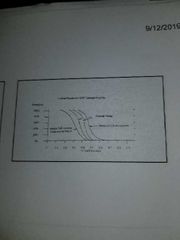![]()
![]()
![]()
Use LEFT and RIGHT arrow keys to navigate between flashcards;
Use UP and DOWN arrow keys to flip the card;
H to show hint;
A reads text to speech;
27 Cards in this Set
- Front
- Back
|
Common finding in all hemolytic anemias |
Increased RBC destruction |
|
|
2 groupings of hemolytic anemias |
Intrinsic (inherited) Extrinsic (acquired) |
|
|
Sites of RBC destruction |
Intravascular Extravascular |
|
|
Inherited (intrinsic) hemolytic anemia types |
Membrane defects RBC enzyme defects Stem cell defects Hemoglobinopathies |
|
|
Ability of an RBC to deform and return to shape is due to |
Flexibility of the membrane Cell surface area to volume ratio |
|
|
Hereditary spherocytosis |
Hemolysis is extravascular (spleen) Low MCHC and low MCV Show increased fragility |
|
|
Osmotic fragility test |
Spherocytes show decreased resistance to hemolysis Increased fragility Can't bend as much as normal RBC |
|
|
How to correct severe hereditary spherocytosis |
Splenectomy Keeps spleen from taking out the spherocytes |
|
|
Hereditary elliptocytosis |
Single dominant autosomal gene Anemia caused by structural defect |
|
|
Other hemolytic anemia due to structural defect |
Hereditary poik Hereditary stomatocytosis Rh null Acanthocytosis |
|
|
Anemia caused by enzyme defects |
G6PD deficiency May be due to drug primaquine, quinine, favas beans |
|
|
Measurement of G6PD deficiency |
G6PD measurement Presence of Heinz bodies Denatured DNA, need supravital stain, can't see on Wright stain |
|
|
Types of acquired hemolytic anemia |
Chemicals, drugs, venom Infectious organisms Immune AB (auto or acquired) |
|
|
Chemical, drugs, venom hemolytic anemia |
Anemia usually stops when causative agent is removed |
|
|
Acquired hemolytic anemia infectious organisms |
Plasmodium falciparun (malaria) Clostridium perfringens E coli 157 |
|
|
Warm type AIHA |
IgG coated red cells are removed by the spleen Extravascular hemolysis |
|
|
Cold type AIHA |
Coated in IgM autoantibodies Cold hemagglutinin Intravascular hemolysis |
|
|
Warm and cold AIHA |
Both IgM and IgG Systemic lupus erythematosis |
|
|
Misc types of hemolytic anemia |
Burns Trauma- DIC causing MAHA Schistocytes present |
|
|
MAHA |
Microangiopathic hemolytic anemia Microthrombi cut RBCs into schistocytes causing anemia |
|
|
PNH |
Paroxysmal nocturnal hematuria One population of RBCs is sensitive to complement |
|
|
Percentage of extravascular hemolysis (liver spleen) |
80% |
|
|
Increased hemolysis impact on bilirubin |
Unconjugated bili increases past livers ability to conjugate it Unconjugated bili builds up in plasma and causes jaundice Urine bili is neg |
|
|
Hemoglobinuria and hemolysis |
Once haptoglobin is saturated with free hgb, hgb will spill out into urine |
|
|
Lab findings with hemolytic anemia |
Possible RBC morphology defect in pbs (spherocytes, elliptocytes, stomatocytes) Incrs Retic |
|
|
Haptoglobin levels for hemolytic anemia |
Decreased |
|
|
Graph of osmotic fragility of cell lines |

|

